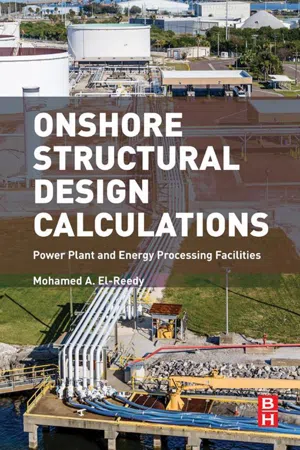
Onshore Structural Design Calculations
Power Plant and Energy Processing Facilities
- 456 pages
- English
- ePUB (mobile friendly)
- Available on iOS & Android
Onshore Structural Design Calculations
Power Plant and Energy Processing Facilities
About This Book
Onshore Structural Design Calculations: Energy Processing Facilities provides structural engineers and designers with the necessary calculations and advanced computer software program instruction for creating effective design solutions using structural steel and concrete, also helping users comply with the myriad of international codes and standards for designing structures that is required to house or transport the material being processed.
In addition, the book includes the design, construction, and installation of structural systems, such as distillation towers, heaters, compressors, pumps, fans, and building structures, as well as pipe racks and mechanical and electrical equipment platform structures. Each calculation is discussed in a concise, easy-to-understand manner that provides an authoritative guide for selecting the right formula and solving even the most difficult design calculation.
- Provides information on the analysis and design of steel, concrete, wood, and masonry building structures and components
- Presents the necessary international codes and calculations for the construction and the installation of systems
- Covers steel and concrete structures design in industrial projects, such as oil and gas plants, refinery, petrochemical, and power generation projects, in addition to general industrial projects
Frequently asked questions
Information
Engineering Management
Abstract
Keywords
1.1 Introduction
1.2 Overview of Field Development
1.2.1 Project Cost Versus Life Cycle
Table of contents
- Cover image
- Title page
- Table of Contents
- Copyright
- Dedication
- About the Author
- Preface
- Chapter 1. Engineering Management
- Chapter 2. Loads on the Industrial Structures
- Chapter 3. Static Equipment Foundation Design
- Chapter 4. Steel and Concrete Storage Tank
- Chapter 5. Steel Structures in Industry
- Chapter 6. Blast Resistance Building Design
- Chapter 7. Design of a Foundation Under Vibrating Equipment
- Chapter 8. Soil Investigation and Pile Design
- Chapter 9. Assessment for Structures in Industrial Plants
- Index